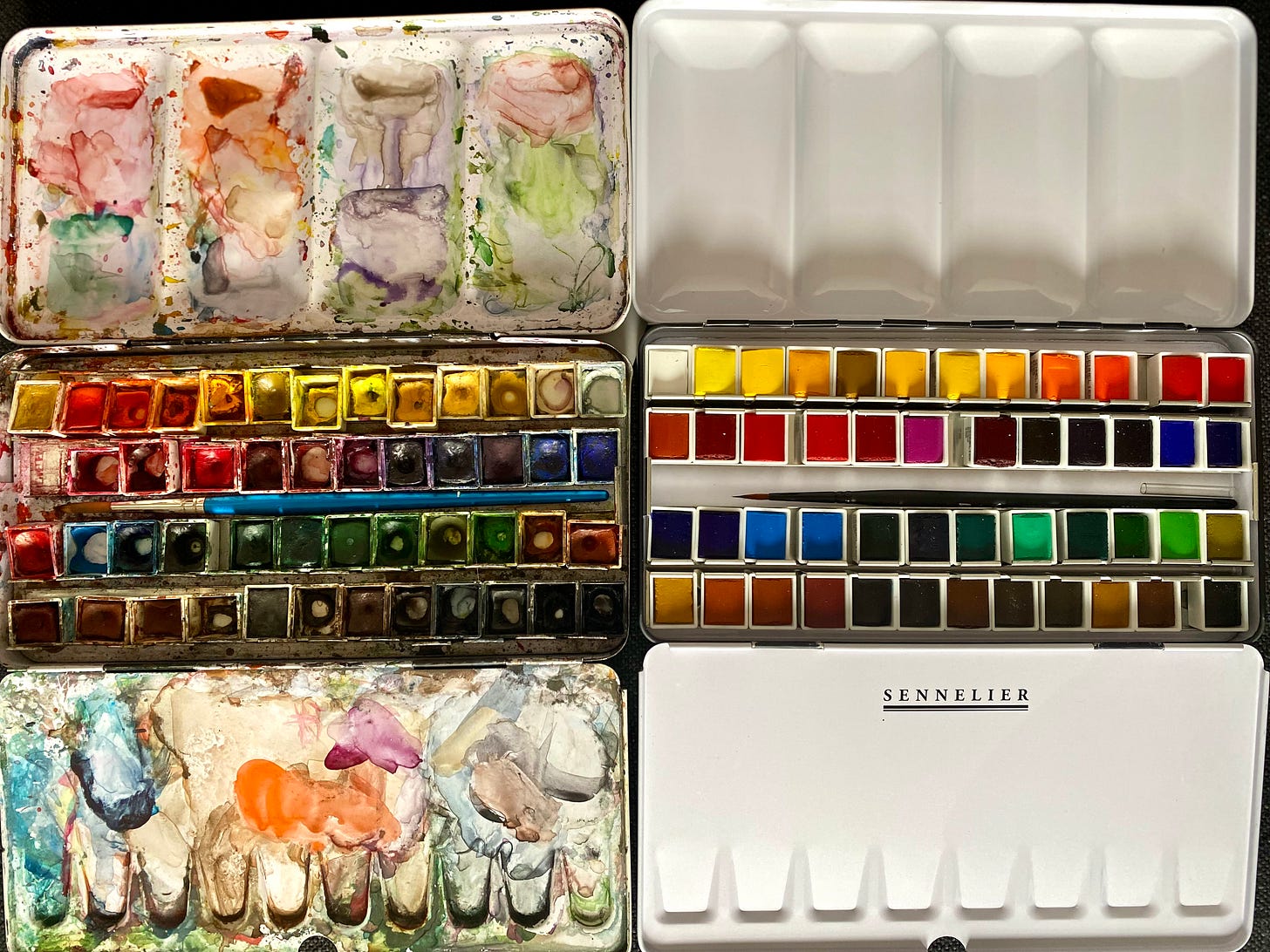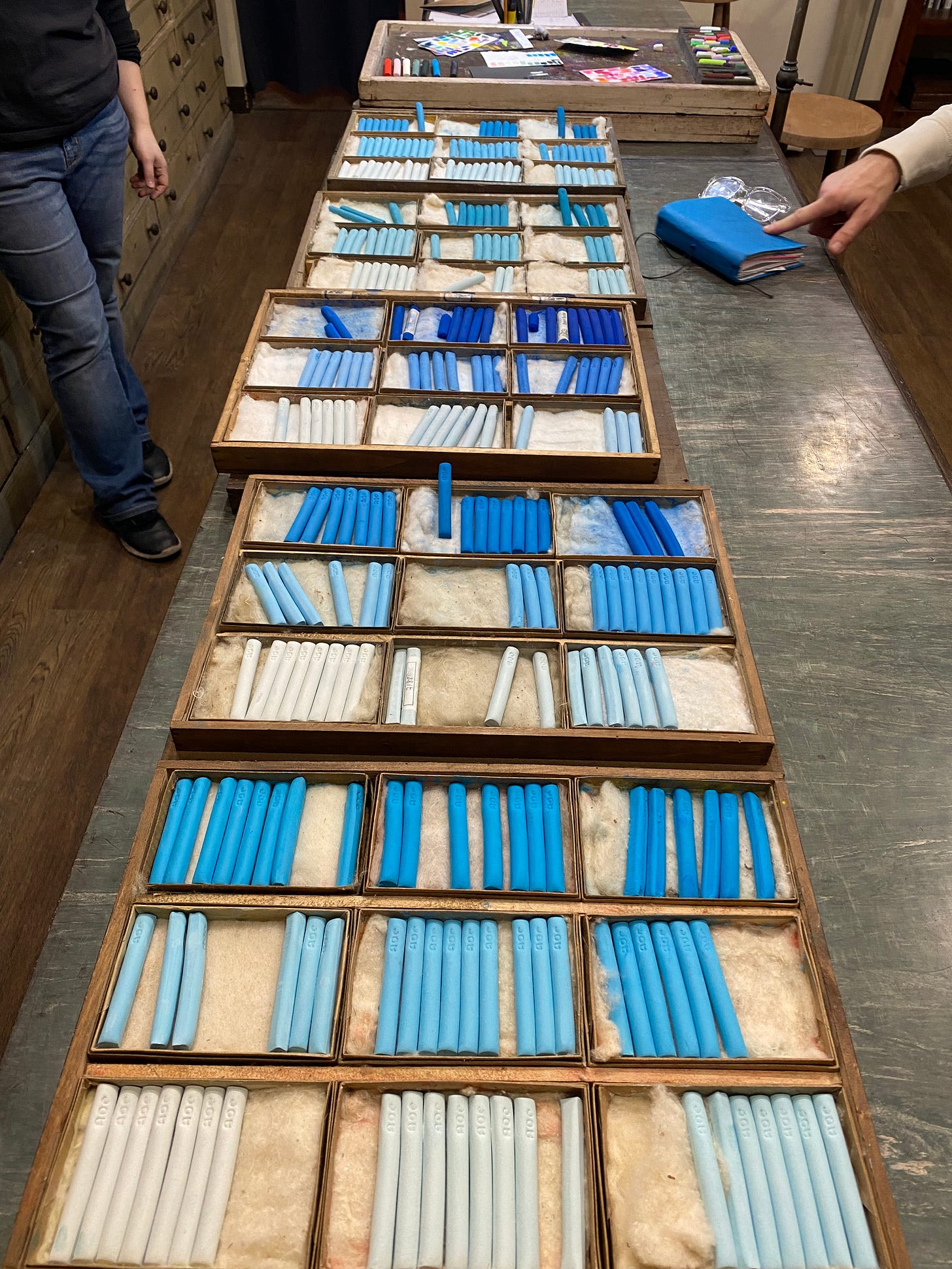The Art Stores of Paris
A pilgrimage to the source of Sennelier Paints and French Pastels
Hey Friends! Before I start, I wanted to let you know that BIG NEWS IS COMING ABOUT THE 30 DAYS DRAWING HABIT! TLDR: after the huge impact it made on people’s creative lives last year, YES WE ARE DOING IT AGAIN! And yes, you should become a subscriber and participate. Keep your eyes peeled for a full announcement coming in a separate email. Okay, more soon.
Meanwhile: I had a piece cued up for us today on curating and protecting our artwork featuring conservationists at the National Gallery of Art in Washington DC (and a recap of DrawTogether’s entire awesome collaboration with them!) And we will do that, I promise. But this week I am taking you along on a trip I just took… to the art stores of PARIS.
Dispatch from Paris’ Art Stores
Last week I went on a pilgrimage to Paris, France to visit two art material manufacturers and sellers: Magasin Sennlier (Sennelier Store) and La Maison du Pastel (The House of Pastel). Also to eat a ton of amazing food, look at art, and wander the streets with the wonderful Kyle. But we’re here to talk about drawing :)
I was so moved by these two magical shops, their supplies, and the people working there, that I had to share the experience with you, tout de suite.
Today I’m going to share a little about the history of these two amazing art material manufacturers and purveyors, show you a little of what I discovered and tell you what I bought for myself. And yes, friends, I SPLURGED.
Let’s start with Sennelier.
Magasin Sennelier
For the first five years of my professional drawing life, I worked with a decent set of standard grade paints with no complaints. They did the job. But on my many trips to the art supply store, I always eyed the Sennelier watercolor kits, and dreamed of a day when I could afford (and justify!) them.
When Samin Nosrat and I got the advance to make Salt Fat Acid Heat, I beelined for an art store in SF called Flax, took a deep breath, and bought myself a full set of Sennelier watercolors. 48 pans of glistening gems. It was glorious. And it was a huge leap for me. Not only in spending (which was substantial), but in taking my materials seriously. It was maybe the first time I truly invested in high quality materials for my work.
Working with the paints over the past ten years taught me a lesson: good art supplies are like good ingredients. While you can draw and paint with anything (sticks and poster paint will truly do!) there is also a reason the good stuff usually costs most. The paint has more pigment, more density, more chroma, more… COLOR. It raised my understanding of what was possible with watercolor paint, and it was worth every darn penny.
Now I use colors from an array of manufacturers (hello Case for Making and Daniel Smith!) But the Sennelier set it still my foundation. I used it to make Salt Fat Acid Heat, How to Say Goodbye, all my columns for the New York Times and California Sunday Magazine, and many, many other books and projects.
It’s been over decade since I bought it. The tin is rusty and won’t stay closed, and the paints are all mishmash-mixes of cakes. I’ve made lost track of what’s what. On the brink of starting another Big Project, I felt like I needed a fresh start.
Hence, this trip to Sennelier. But this time, in Paris.
Sennelier: A Little History
Paris art supply store Sennelier was founded in 1887 by Gustave Sennelier. Located on the Left Bank of the River Siene, it’s just down the street from the world-renowned art school L’Ecole des Beaux-Arts, where Degas, Delacroix, Renoir, and Seurat and so many other European artists learned to draw and paint.
Since it opened its doors, Sennelier has created and sold materials to some of Europe’s most famous artists, and has contributed to the advancement of art around the world.
A little art supply history
Apologies in advance to my fellow animal lovers out there, but did you know that paint used to be stored in pig bladders? This made it difficult for artists to transport their paint, and kept them painting inside their studios for the most part. It wasn’t until 1841 that American artist John G. Rand invented a small object that would change the course of art (and commerce): the tin paint tube. The invention of the paint tube made it possible for artists to travel with their materials. This allowed them to be able to work on site, which in turn launched plein air, or the technique of painting from life, outdoors. Without this advance, the whole school of Impressionism might never have happened, nor the advances in perception - in both art and science - that accompanied it. What’s more, those tin paint tubes and the increasing use of machines to create materials helped make supplies more accessible (cheaper!) which increased the number of people paintings, which increased the overall demand for art supplies. This in turn led to more art supply shops. In 1817, there were 79 art/color supply stores in Paris. By 1885, there were 600.1
Sennelier enters the scene
When Sennelier opened his shop on the left bank in Paris in 1887, he sold an array of paints by all sort of different manufacturers. However, when artists came in asking for colors he didn’t have, he decided to make the paints himself. He took classes on chemistry and paint making, then “travelled all over Europe to buy the best raw materials: pigments from minerals, plants and animal bones.”2
He began making his own paints, and word spread about the quality of his supplies. That and his openness to working with artists to create custom colors and materials made his shop a destination for artists from all over.
Painters like Gaugin and Bonard bought paints from Sennelier. Degas purchased his soft pastels from Senellier, and the worked together to develop a line of browns distinctly for Degas. In 1948 Pablo Picasso approached Sennelier requesting a stick of color he could use on any surface, but without first having to do special preparation or coating. Henri Sennelier, Gustave's grandson, created for him the oil pastel3, a stick of colored chalk that is waxy rather than powdery. It goes on thickly and won't smudge.4
Today, Sennelier is run by descendants of Gustave. They continue to work with contemporary artists to create custom materials for their work, including folks like David Hockney. And their materials have become a global brand.

A helpful salesperson named Aurelie patiently helped me with paint and paper (Kyle was drooling over all the papers he could use to make books!) She’s worked there for over 10 years and pointed me towards some of the more interesting inks, pens and paper. Merci Aurelie!

What I bought
A new full set of Sennlier paints. 🥹
Eight sheets of handmade watercolor paper from Paris, and a few new multimedia papers to try as well, including one made from bamboo, and one from donkey dung!
Three new Synthetic Brushes to try. Ii’m always looking for a great synthetic replacement for squirrel and sable - these animals are raised and killed inhumanely for the hair for our brushes, i’m sad to say.)
My favorite pen nibs. I haven’t been able to find anywhere!!
I spent about an hour or so digging through all the shelves and drawers, ogling all the paints and bottles, touching all the papers and brushes, and trying all the pens. I only left because they close for lunch. If I could do it over again I’d call and make an appointment to interview the proprietors about their work - there are so many stories in that shop. Or at least make sure I had two hours to explore. If you have a chance to visit Paris, put Sennelier at the top of your list.
And right next to Sennelier, scribble this:
La Maison du Pastel
History of La Maison du Pastel
Established in 1720 by Henri Roche, La Maison du Pastel is the oldest pastel manufacture in the world, with their material used by artists like Degas. Today, the company is run and operated by Isabelle Roché, a distant relative of founder Henri, and Margaret Zayer. The two women make every stick by hand, and are constantly inventing new colors to sell in their Paris shop.
Honestly, just stop reading right now and WATCH THIS VIDEO on the how Isabelle and Margaret make pastels:
What I discovered
La Maison du Pastel only opens its doors to the public for 4 hours a week. Naturally, people travel from all over to visit in person. The upside of being in the actual shop - I mean besides standing inside a gorgeous piece of history - is that you can see the selection of colors in person and test them out on paper.
In addition to making all the pastels, Isabelle and Margaret hand sell each stick to customers, so visitors can any question about the colors or their creation. When I was there, Margaret had been working with a woman for two and half hours to make sure the colors the woman chose were what she needed.

What I bought
At nearly 20 bucks a pop for a full stick (half are only sold in their pre-determined sets) I was going to splurge on three pastels. But how can one choose?? I went for SIX.
Here they are:
Pastels are not my medium, but I’m inspired to experiment with them and learn more. Are you all interested in trying along with me?? Mistakes will be made. With colors like this, how could they be anything other than spectacular?
Au Revoir!
Thanks for accompanying me on a perfect visit to do some art supply learning, and experimenting (and importing!)
If anyone has the chance to visit Paris anytime in the future, I can’t recommend visiting Sennelier and Maison du Pastel enough - and speaking with their proprietors.
We’re now able to get most of these supplies online, which is great. But when we can go to the source and learn - smell and touch and listen and learn about the centuries of hard work and care that goes into every pastel and watercolor pan and piece of paper will make you appreciate your materials all the more, and feel connected all the artists who have come before you. And bring that connection home with you, and put it into your artwork.
ASSIGNMENT
This week, let’s take a little dive into materials - and experiment with a new medium.
















